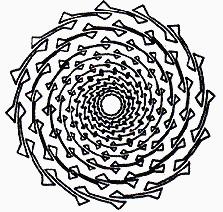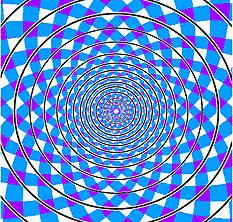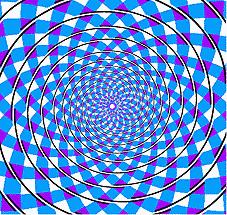|
|
||||||||
 |
||||||||
 |
||||||
 |
||||||
 |
||||||
| THINGS
TO DO AND NOTICE
On the left you see the
Fraser spiral. The overlapping black arc segments appear to form a spiral;
however, the arcs are really a series of overlapping concentric circles.
On the right, we have connected the overlapping segments, so that the illusion
is broken. If you cover half the figure (the one on the left), this will
also cause the illusion to be reduced. This means that a global perception
is needed to cause the overall effect.
What's Going On? The Fraser spiral is related to the twisted cord, Münsterberg, and café wall illusions. The Fraser spiral, however, is the most complex of the twisted cord illusions, and some additional factors may be involved in the visual processing of this illusion. In this case, even though the twisted cords themselves trace out circular paths, each of the directional units gives rise to a perception of a spiral. The illusion is augmented because there are spiral components in the checkered background. On the left you can see the illusion is greatly reduced when one removes the checkered background, but it is still present. If the directional units are grouped with those in neighboring cords, these groupings would also follow an underlying spiral path. All three illusions demonstrate
the effect of simple image processing occurring at the retina combined
with some complex processing in the cortical cells of the striate cortex..
The spiral effect is likely due to orientation-sensitive simple cells found
in this area. For example, the contextual effect that is a result
of horizontal connections between "like" cells in V1. Cross-correlation
patterns between pairs of cells are not completely static but change somewhat
depending on context. The cells interact with one another to interpret
the diagonal bands produced by the retina as a single continuous line,
tilted in the direction of the directional units.
|
||||||